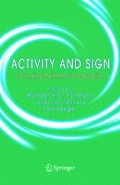Abstract
By means of an epistemological analysis of a teaching episode from a mathematics classroom the paper tries to exemplify and to concretize some fundamental ideas developed in a theoretical perspective by Michael Otte towards the basic role of visualizations and metaphors for mathematics teaching. The metaphor “The equation is a balance” is taken as a paradigmatic case. “The equation is a balance is a sentence not to be taken verbally, and the seemingly abstract (the algebraic equation) cannot be limited to the seemingly concrete and empirical (the balance) in a process of reduction and of visualization, but on the contrary, the balance represents the highly general meaning of the interaction or the reciprocity or it stands for the dynamic and compensation. … The real balance has meaning for the equation. The algebraic concept of equation could not have been constituted without the experience of the balance” (Otte 1984).
Access this chapter
Tax calculation will be finalised at checkout
Purchases are for personal use only
Preview
Unable to display preview. Download preview PDF.
References
Church, J. (1971). Sprache und die Entdeckung der Wirldichkeit. Frankfurt am Main: Suhrkamp.
Duval, R. (2000). Basic Issues for Research in Mathematics Education. In T. Nakahara, & M. Koyama (Eds.), Proceedings of the 24th International Conference for the Psychology of Mathematics Education. Hiroshima, Japan: Nishiki Print Co., Ltd. I., 55–69.
Duval, R. (1993). Registres de représentation sémiotique et fonctionnement cognitif de la pensée. In Annales de Didactique et des Sciences cognitives 5, 37–65.
Frege, G. (1969). Funktion, Begriff, Bedeutung. Fünf logische Studien. Göttingen, Vandenhoeck & Ruprecht.
Jahnke, H. N. (1978). Zum Verhältnis von Entwicklung und Wissensbegründung in der Mathematik — Beweisen als didaktisches Problem. Materialien und Studien des IDM, Band 10, Bielefeld: Universität Bielefeld.
Lakoff, G., & Johnson, M. (1980). Metaphors We Live By. Chicago: The University of Chicago Press.
MacGregor, M. (1998). How Students Interpret Equations: Intuition Versus Taught Procedures. In H. Steinbring, M. Bartolini-Bussi, & A. Sierpinska (Eds.), Langugage and Communication in the Mathematics Classroom. Reston, VA: National Council of Teachers of Mathematics, 262–270.
Maier, H., & Bauer, L. (1978). Zum Problem der Fachsprache im Mathematikunterricht. In Schriftenreihe des IDM Bielefeld 18. Bielefeld: Universität Bielefeld, 137–153.
Ogden, C. K., & F. A. Richards (1923). The Meaning of Meaning. London: Routledge and Kegan.
Otte, M. (1984). Was ist Mathematik? Occasional Paper 43 des IDM, Bielefeld: Universität Bielefeld.
Pinker, S. (1998). Der Sprachinstinkt. München: Knaur.
Sacks, O. (1990). Stumme Stimmen. Hamburg: Rowohlt.
Rotman, B. (2000). Mathematics as Sign. Writing, Imagining, Counting. Stanford, California: Stanford University Press.
Steinbring, H. (1989). Routine and Meaning in the Mathematics Classroom. For the Learning of Mathematics 9.1: 24–33.
Steinbring, H. (1991). The Theoretical Nature of Probability in the Classroom. R. Kapadia and M. Borovcnik (Eds.), Chance Encounters: Probabilitiy in Education. Dordrecht: Kluwer Academic Publishers, 135–167.
Steinbring, H. (1997). Epistemological investigation of classroom interaction in elementary mathematics teaching. Educational Studies in Mathematics 32, 49–92.
Steinbring, H. (1998a). Elements of Epistemological Knowledge for Mathematics Teachers. Journal of Mathematics Teacher Education 1.2, 157–189.
Steinbring, H. (1998b). Mathematical Understanding in Classroom Interaction: The Interrelation of Social and Epistemological Constraints. In F. Seeger, J. Voigt and U. Waschescio (Eds.), The Culture of the Mathematics Classroom. Cambridge, UK: Cambridge University Press, 344–372.
Whitehead, A. N. (1948). Eine Einführung in die Mathematik. Bern: Francke Verlag.
Author information
Authors and Affiliations
Editor information
Editors and Affiliations
Rights and permissions
Copyright information
© 2005 Springer Science+Business Media, Inc.
About this chapter
Cite this chapter
Steinbring, H. (2005). Do Mathematical Symbols Serve to Describe or Construct “Reality”?. In: Hoffmann, M.H., Lenhard, J., Seeger, F. (eds) Activity and Sign. Springer, Boston, MA. https://doi.org/10.1007/0-387-24270-8_9
Download citation
DOI: https://doi.org/10.1007/0-387-24270-8_9
Publisher Name: Springer, Boston, MA
Print ISBN: 978-0-387-24269-9
Online ISBN: 978-0-387-24270-5
eBook Packages: Humanities, Social Sciences and LawEducation (R0)

